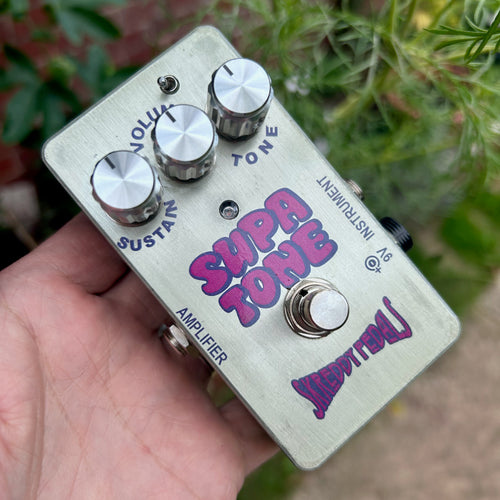Effects: Fuzz, Germanium
The B100 Fuzz is a germanium fuzz based on the Neve B100 preamp card found in the 1053 and similar channel strips that preceded Rupert Neve's now famous 1073. When researching these modules I found the topology was similar to a two transistor fuzz, and with some experimentation I was able to get a nasty, high gain fuzz that also has a sweet side. By balancing the input and gain controls you can get smoky OD tones and warm, clean tones akin to a clean germanium preamp. Or you can dime both controls for a massive wall of fuzz that will move mountains (figuratively). The input control has an effect on the low end, while the gain has a focus on the mids and highs. This acts a pseudo EQ that helps give a little tone control.
Although a two transistor fuzz is relatively simple, there were some unique circuit elements that I carried over from the original Neve design that aren't typically found in fuzz pedals. I was hesitant to release a fuzz that was a clone of past designs, and as you will find familiarity in the sound, there is something unique about it that I'm proud to put forward. It has the width and compression of a vintage fuzz, and the cut and focused image from a modern device.
The build is a mix of the old and the new. Carbon film 1/2 watt resistors are paired with Polypropylene film caps for classic tone while making the fuzz feel fast and responsive. The only electrolytic in the audio circuit is a high grade bipolar MUSE cap, while the power caps are the trusty Panasonics. This batch is made using 2N404A transistors, which gives lots of grunt and grit when driven but are tasty and warm at low gain. Powder coat is a metallic teal with retro colored graphics on a custom folded aluminum chassis.
The B100 can be loud depending on the load, if you go for maxed input and gain, keep the output low to start or you will likely hear the following circuit clipping, over the actual sound of the B100. Inversely the output is very useful as a makeup stage when going for low gain tones.
Every pedal's transistor pairing is auditioned, matched, and biased to a sweet spot for the circuit. Users can induce extra gating effects or compensate for temperature effects on the germanium by adjusting the internal bias control.
B100 Fuzz







